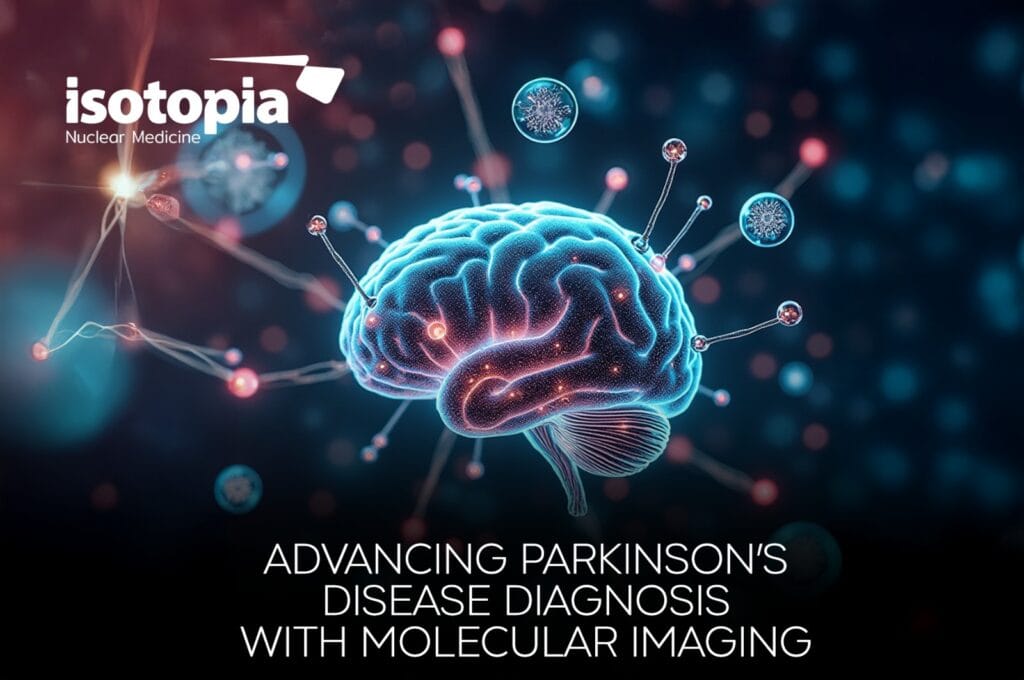As we observe International Parkinson’s Disease Day, it is important to reflect on the advancements in diagnosing and understanding this challenging neurodegenerative condition. Among the sophisticated tools available, Positron Emission Tomography/Computed Tomography (PET/CT) using the radiotracer [18F]-L-Dihydroxyphenylalanine ([18F]-FDOPA) stands out as a significant contributor to the diagnostic process.
Parkinsonian syndromes, including Parkinson’s disease (PD) and atypical parkinsonisms like Progressive Supranuclear Palsy (PSP), Multiple System Atrophy (MSA), Dementia with Lewy Bodies (DLB), and Corticobasal Degeneration (CBD), present overlapping clinical features that may complicate diagnosis. While neuropathological examination remains the gold standard, it can only be confirmed postmortem. This is where molecular imaging, particularly with [18F]-FDOPA, plays a vital role by allowing for in vivo assessment of the presynaptic dopaminergic pathway.
How does [18F]-FDOPA PET/CT aid in diagnosing Parkinson’s disease?
Visualizing Dopamine Deficiency: [18F]-FDOPA is a radiotracer that assesses the activity of aromatic amino acid decarboxylase (AADC), an enzyme crucial for dopamine synthesis in the brain’s neurons. By tracking the uptake of [18F]-FDOPA, PET/CT imaging can directly visualize the integrity and function of these dopaminergic pathways. In neurodegenerative parkinsonism, damage to these pathways leads to reduced dopamine production, which is expressed as decreased [18F]-FDOPA uptake in specific brain regions, particularly the striatum (putamen and caudate nuclei).
Detecting Early-stage Disease: Notably, even in the mildest stages of PD (Hoehn-Yahr grade 1), bilateral reduction in [18F]-FDOPA uptake in the basal ganglia can be observed, at times even contralateral to the side without obvious clinical motor symptoms. This high sensitivity allows for the detection of dopaminergic impairment early in the disease.
Differentiating Neurodegenerative from Non-Neurodegenerative Parkinsonism: A key application of [18F]-FDOPA PET/CT is in distinguishing neurodegenerative parkinsonism from non-neurodegenerative causes such as vascular parkinsonism, drug-induced parkinsonism, psychogenic parkinsonism, and essential tremor. In many of these non-neurodegenerative conditions, the presynaptic dopaminergic system may remain intact, resulting in normal [18F]-FDOPA uptake patterns. According to the “International consensus on clinical use of presynaptic dopaminergic positron emission tomography imaging in parkinsonism” [1], a normal presynaptic dopaminergic PET scan is listed as one of the absolute exclusion criteria for PD.
Supporting Differential Diagnosis among Atypical Parkinsonisms: While decreased [18F]-FDOPA uptake generally indicates a neurodegenerative parkinsonism, the pattern and extent of this reduction can often provide clues for differentiating between PD and atypical parkinsonisms. For example, in PD, the reduction often begins in the posterior putamen and progresses asymmetrically. However, the “Brain Evaluation by Dual PET-CT with [18F] FDOPA and [18F] FDG in Differential Diagnosis of Parkinsonian Syndromes” [2] study found that while reduced uptake in the posterior third of the putamen was common across parkinsonisms, asymmetrical patterns were frequent in MSA-P, and MSA-C was the only diagnosis displaying both symmetrical and asymmetrical patterns.
The Value of Dual [18F]-FDOPA and [18F]-FDG PET/CT:
The “Brain Evaluation by Dual PET-CT with [18F] FDOPA and [18F] FDG in Differential Diagnosis of Parkinsonian Syndromes” [2] study strongly advocates for the use of dual-tracer PET/CT, combining [18F]-FDOPA with [18F]-Fluorodeoxyglucose ([18F]-FDG). While [18F]-FDOPA assesses the dopaminergic system, [18F]-FDG evaluates brain glucose metabolism. The study concluded that this dual technique stands out in differentiating between types of parkinsonisms, corresponding significantly with clinical diagnoses, especially during follow-up.
As highlighted in both sources, the information from [18F]-FDOPA PET/CT, especially when combined with [18F]-FDG PET/CT, provides valuable insights that complement clinical assessments, potentially leading to earlier and more accurate diagnoses of Parkinson’s disease and other parkinsonian syndromes. This is crucial for optimizing patient management, prognosis, and the development of targeted treatments.
On this International Parkinson’s Disease Day, let us recognize the power of molecular imaging techniques like [18F]-FDOPA PET/CT in enhancing our understanding and diagnosis of Parkinson’s disease, with the ultimate aim of improving the lives of those affected by this condition.
References
Tian M, Zuo C, Cahid Civelek A, Carrio I, Watanabe Y, Kang KW, Murakami K, Prior JO, Zhong Y, Dou X, Yu C, Jin C, Zhou R, Liu F, Li X, Lu J, Zhang H, Wang J; Molecular Imaging-based Precision Medicine Task Group of A3 (China-Japan-Korea) Foresight Program. International consensus on clinical use of presynaptic dopaminergic positron emission tomography imaging in parkinsonism. Eur J Nucl Med Mol Imaging. 2024 Jan;51(2):434-442. doi: 10.1007/s00259-023-06403-0. Epub 2023 Oct 4. PMID: 37789188.
Sinisterra Solís FA, Romero Castellanos FR, Cortés Mancera EA, Calderón Ávila AL, González Rueda SD, Rosales García JS, Kerik Rotenberg NE, Tristán Samaniego DP, Bonilla Navarrete AM. Brain Evaluation by Dual PET/CT with [18F] FDOPA and [18F] FDG in Differential Diagnosis of Parkinsonian Syndromes. Brain Sci. 2024 Sep 18;14(9):930. doi: 10.3390/brainsci14090930. PMID: 39335427; PMCID: PMC11429636.

Haim Golan
MD MSc
Chief Medical Officer
Medical Adviser
Isotopia Molecular Imaging LTD





